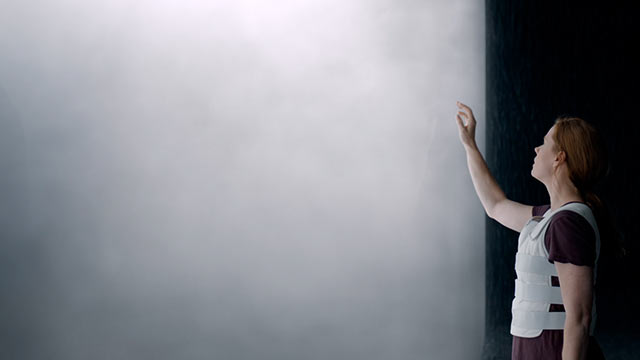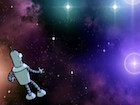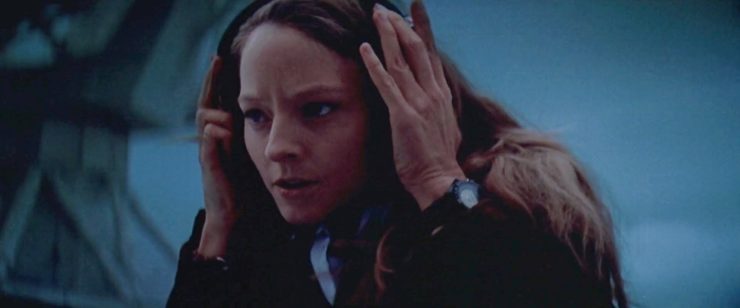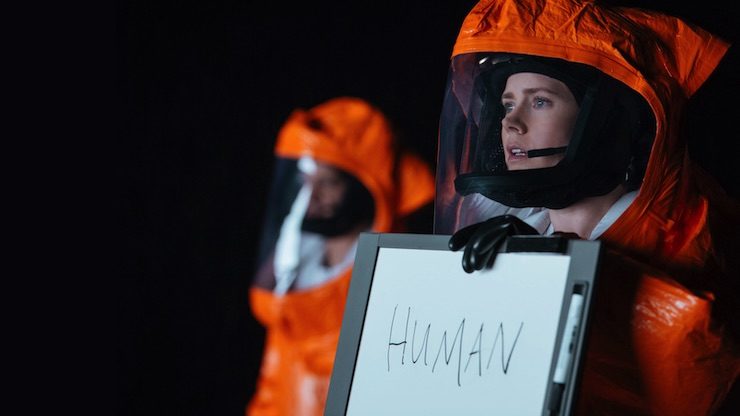There’s a moment in Arrival where Louise (played wonderfully by the always perfect Amy Adams) is in the alien spacecraft and, acting against military orders, she removes her protective suit. The soldiers accompanying Louise’s mission to find a way to communicate with the aliens—dubbed the heptapods—don’t know how to respond. Do they stop Louise? Abort the mission? Something worse? Despite knowing the air is breathable and the atmosphere is harmless, the soldiers are still stunned by Louise’s decision, and they are absolutely unwilling to follow her lead. They don’t share her impulse or her willingness to take a risk.
But, most of all, they don’t share her faith.
Faith, of course, is a very tricky thing to discuss. When I think about faith in the context of a movie like Arrival, I’m not drawing on the binary discussion “do you or do you not believe in God?” To me, the idea of faith is more general in the sense that it covers any devotion to a higher being or spiritual power. It could be anything, from a religion-based god to alien overlords to the Force. The point is that you believe in something outside yourself that, in some way, shapes, influences, or even controls the nature of our world. Yet somehow, regardless of the faith, the path to getting there is always the same: you have to hear the call, and then you have to take conscious steps to overcome that adversity within and without to reach its source, taking you from a non-believer to a believer.
What’s interesting about Arrival in this faith-based context is how directly it deals with the first half of the bridge to becoming a believer—hearing the call. The movie is centered on this mission to learn how to communicate with an alien race who may or may not want to destroy all life on Earth. As one of the world’s foremost linguists, Louise is presented with the challenge of understanding what, exactly, the heptapods are trying to tell humanity. While her expertise is the defining reason for her ability to crack the heptapod language code, her most remarkable success—preventing a nuclear attack—is the product of her willingness to take steps no one else will. The removal of her suit, as mentioned above, is just one of those steps on her path to crossing a threshold between skepticism—and maybe even fear—to belief and trust. In fact, much of her journey over the course of the movie can be seen as an allegory for faith. The closer she gets to the aliens, the more she begins to change and be affected. As Louise’s ability to communicate with the aliens gets better and better—as she hears their call more clearly—so, too, is the profound change happening within herself. By the end of the film, we learn that the aliens have gifted Louise an ability that aligns with what many commonly associate with the attainment of belief: clarity of vision, purpose, and thought. Louise transforms from a skeptic to a believer over the course of Denis Villeneuve’s brilliant sci-fi drama.

This process of evolving with your faith isn’t anything new. Christians have a tool called the Bridge to God (or sometimes called the Bridge to Life), which is more or less a model that guides people from lonesome wandering to the holy embrace of their god. In this model, you start on one end of the bridge, removed from god. But despite this separation, you still hear the call—like the heptapods calling out to humanity in Arrival. The journey, then, is akin to Louise’s, and it’s a conscious decision to travel a path, guided by faith, that leads you closer to god.
Similarly, Joseph Campbell illustrates this growth in his deconstruction of the hero’s journey, and we see it in practice in Star Wars (Campbell’s writings were hugely influential on George Lucas). At the end of A New Hope, Luke literally hears Obi-Wan’s call, urging him to trust in the Force and destroy the Death Star on his instincts alone. Like Louise removing her suit when everyone else advised caution, Luke also took that first, important step toward believing in something he could hardly comprehend. From there, he embarked on a journey that took him to the swamps of Dagobah, the gallows of Bespin, and, finally, to a full Jedi where he embraced not only the power of the Force, but also the spirit of his own father.

The underlying idea of this call to faith is that anyone can hear it. In the 1997 film Contact—which I read as a spiritual cousin to Arrival—a brilliant scientist determined to prove humans aren’t the only sentient life in the galaxy comes in, well, contact with a message beamed from a faraway race of aliens. Based on the Carl Sagan novel, Contact, like Arrival, deals directly with decoding a message. What this scientist (Ellie, played to perfection by Jodie Foster) hears way out in the Vega system isn’t a simple bit of text; it’s a layered transmission containing sound, video, and information. And, like Louise in Arrival, Ellie is surrounded by people who remain both skeptical and even fearful of the message they, too, are hearing. They don’t know the intention of the call, and that makes them hesitant to trust its source. But both Ellie and Louise pursue their belief that something vital, something profound, is in the message they are trying to decipher, and they’re both rewarded for their steadfast dedication: Louise communicates with the heptapods and not only betters the world because of it, but she also comes to terms with the greatest tragedy of her life; Ellie speaks with the aliens, in the form of her father, and has her existential journey, that she—that humanity—isn’t alone, confirmed.

(It’s worth noting that Contact is also dealing with the intersection of faith and science, but in a different way than discussed here; the text in Contact is more about proving belief, whether it’s belief in science or god, and it is excellently presented throughout the film.)
Thinking of how the path to embracing faith is woven into the fabric of Arrival, it’s interesting that so many people have watched the movie and have said how it has restored their faith in humanity. For many people in this country, and around the world, there’s a sentiment that we’re about to enter in a period of frightening uncertainty, and regardless of whether you agree with this concern or not, one thing is for certain: Divisiveness amongst people over culture, over politics, over everything is at a zenith. That’s why Arrival has become the perfect movie for this time. As a story about the power of communication and how it can unite people and races despite their differences, it couldn’t have been released at a better moment in history. But not only that, like Contact before it, Arrival is a movie about the journey of faith and how, through taking that journey, we can shed light on even our most existential questions. Both films serve to remind us that, no matter what, life is always worth living.
It just needs to be believed in.
Michael Moreci is the writer and co-creator of several comics series, including Roche Limit, Hoax Hunters, Curse, Burning Fields, Transference, and ReincarNATE. Four of his properties are currently in development for TV and film, and he is currently working on two sci-fi space adventure novels coming from St. Martin’s. Moreci lives in Chicago with his wife and two children, his greatest co-creations of all.











Maybe I missed it, but I don’t see anything pointing to what you are saying Louise has faith IN.
Is it technology? (faith in the instruments that say the air is safe in the heptapod ship?)
Is it the heptapods themselves? (faith that they mean well in spite of the general trend to the opposite?)
Is it faith in her own skill? (faith in her translation vs the other experts’ opinions?)
Your point that Arrival is a journey to Faith kind of falls flat without saying where that journey ended.
Hey Ridiculon!
I think that’s a good question. My answer would be faith in the hetapods, but not in the sense that Louise had a specific reason to be faithful in them. She didn’t know where the path the hetapods were leading her on, but she traversed the road nonetheless. I think that’s true for a lot of faith, in that you don’t know–not really–what’s on the other side. Right? Holy texts can give you an idea, I suppose, but not much more than that. So Louise’s faith that the hetapods’s purpose was to deliver something vital–and, as the movie progressed, it seemed to me that she was learning that she was gaining something profound from them–is the important part of their relationship, especially in context with how just about everyone else viewed the hetapods (with skepticism and fear). The same goes for Contact–Ellie doesn’t know what these aliens have to offer, she just has a sense that it’s essential, and that forces her to put her faith in them. You can even make the leap to a Christian belief system, where people can have a sense of the rewards for their faith, but they don’t really know.
That all said, again, I see what you’re saying, and it is a bit nebulous. So, too, is faith, I’d say.
Thanks for reading and inquiring!
That makes more sense now haha, it was just bothering me that you didn’t specify which thing she had faith in.
Although I would argue that by the end of the movie she seems to share the heptapods’ faith more than she has faith in the heptapods themselves. Both Louise and the heptapods show faith in the predictions of the future they have access to through the universal language, although Louise, being a scientist, tests her faith as soon as she understands whats happening. She does gamble quite a bit on that test however, so I guess you could say she has a high degree of confidence in her new faith?
I agree, and that’s a good point! Because the hetapods, too, are placing faith in the humans not to screw the entire mission up, haha (although could they see the future where it all worked out? Hrmmm…). I think you say it great–it’s a shared faith, and thinking about that adds a nice layer to the story.
You’re basing this entire article on the fact she has faith that when she takes off her suit she’ll be able to breath the atmosphere but like any good scientist she takes this decision after observing the bird in the cage is still very much alive. It’s not faith, it’s logical conjecture based on overwhelming observable evidence (thanks to the church of the FSM).
Although now that I think about it… is it really faith if you test it and get a result? (just talking about the actual definition of the word ‘faith’ here)
True, politeruin, but no one else takes off their suits. They’re all terrified and skeptical, and they have the exact same evidence as Louise (they seem to all be working off the assumption that the heptapods are a foe, not a friend, which is something the film doesn’t at all hide). Sure, you can say it’s all science, but it’s not the first science v faith debate to come along; you could say it’s all science and she knew, but you can just as easily add that they were in an alien ship, and the idea that there were things in their human instruments can’t detect are a very real possibility–hence why the others wouldn’t remove their suits and why Louise, IMO, took a leap of faith. Science + faith.
I’m not sure what you mean, Ridiculon. Can you explain a bit more? Definitely interested in what you have to say, of course.
Bridge to God? I’ve been a Christian since August 28, 1980–the evening I was immersed–and that’s new to me. Hmmm . . .(musing).
Yeah, I’ve never heard of the “bridge to God” either, and I’m a former seminary prof who has taught in seminaries of three different denominations. Whatever the “Bridge to God” is, it’s not broadly known of by Christians in general.
But I agree it’s interesting to think of both Arrival and Contact in terms of faith, whether religiously or non-religiously construed. The two films make a great pair for analysis, in any case. And they’re both fine SF movies centered on a great female character superbly acted, so that’s a plus!
That’s interesting you guys never heard of it, because when I was writing this article, I could find very little online (except for this: https://www.navigators.org/Tools/Evangelism%20Resources/Tools/The%20Bridge%20to%20Life and a few other mentions). I actually had an illustrated version of the Bridge to God in my wallet since 1999, but when I lost my wallet about a year ago, I lost the copy as well. Maybe it’s not as prevalent as I thought? I pasted a little picture I found via google as well. Very simplified, but that’s the gist.
And saavik, I agree–those two movies make an excellent pair, for a lot of discussions. Thinking of all this makes me excited to watch them back to back when Arrival is available for home viewing.
I grew up as Methodist, then Non-Denominational (which you could argue is a denomination), and I definitely remember the Bridge to God being taught.
They definitely left the fires of hell under the bridge out of the graphic though. Haha.
I’ve not seen the movie yet, but I read the novella.
From what I’m gathering, unless they radically changed the events in the adaptation, it seems to me very much a case of projecting yourself in what you’re seeing…
The novella theme I saw was very much contrary to any religious principle, as it involved the complete surrender of free will: achieving understanding of the alien point of view, implied yes access to the knowledge of the future, but at the same time involved losing any possibility to change actions, falling in a railroad of predetermined actions, and abandoning our vision of time as a series of things that happens in sequence.
There *is* an acceptance element involved, but it’s an acceptance that derives from rationally understanding the different point of view, not surely from faith.
If anything, they resemble a (slightly more realistic) version of the Tralfamadorians from Vonnegut’s Slaughterhouse n.5.
An equally valid article might be drawn up that places trust rather than faith at the centre of the movie’s message, tied to its importance in successful communications. I think there’s no question that the air is breathable and Louise can take off the suit. The soldiers hesitate for the reason the bird is there: so they’ll know if the aliens suddenly poison the atmosphere. Soldiers are trained to be wary that way. Louise is trusting that this is not the aliens’ intent. Trust in her mind is tied to successfully communicating with them. She can take that step, or she can give up now.
Apparently humans have a built-in need for faith. The article mentions two movies in which entirely secular, rationalist scientists have to make “leaps of faith” and this is shown as the right choice. They are miracle tales for atheists.
9, 10,11,12
I’m a Anglican priest, with a degree from Cambridge in theology. I’ve never heard of it either – though the illustration you provide looks like something I might have seen in a tract once, though not under that title.
I’m guessing that it’s something that’s prominent in conservative evangelical circles, and pretty specific to that part of the church.
(I liked the article, but that was a really confusing moment).
Hoax Hunters? I remember that comic! Are you ever going to continue it?
And FWIW, I’m evangelical, and I’ve seen a form of that illustration before at least once. I don’t think I ever heard a specific name for it, but I recognized what you were talking about from the description.
I guess what you see in the movie depends on where you’re coming from.
While I can see a link with faith in the movie, for me it is more a faith in the rationality of the heptapods, and the realisation that if their goal is to cause harm they can certainly do so at their whim, regardless of any protective measures taken by the humans.
Ultimately the belief is that the visitors did not undertake an interstellar journey just for the purpose of torturing some hapless natives, and that if they did, humanity is pretty much screwed anyway.
It follows logically that the best way to learn the true larger purpose of the visitors is to remove as many barriers to understanding as possible, thus the removal of the suit.
I first saw the illustration of the “Bridge” in 1977. I was in my first year in college and a friend at my summer job went through it with me at lunch one day. He was a member of the Evangelical Free Church in that medium sized Nebraska college town. I’ve always felt that was a large tenet of the Evangelical movement that seemed to grow from that period of time. If you happened to be a member of an older, more established Protestant denomination, I can well believe that you would not have heard of it before.
“Hoax Hunters? I remember that comic! Are you ever going to continue it?”
Hey Matthew! Good question, and thanks for remembering HH. I plan on continuing it at some point in the future, when time allows. I love that universe, and there’s still lots of stories to tell there.
Thanks for asking!